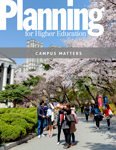- Integrated Planning
Integrated Planning
Integrated planning is a sustainable approach to planning that builds relationships, aligns the organization, and emphasizes preparedness for change.
- Topics
Topics
- Resources
Resources
Featured Formats
Popular Topics
- Events & Programs
Events & Programs
Upcoming Events
- Building Buy-in for Planning: Dealing With Resistance and Gaining Support
Online | March 11 – April 8 - Budgeting for Impact: A Working Group on Resource Planning in Higher Education
Online | Feb 5, Feb 19, March 5 - Cross-Functional Collaboration: Tools and Skills for Working Across Silos
Online | February 10, 17, 24
- Building Buy-in for Planning: Dealing With Resistance and Gaining Support
- Community
Community
The SCUP community opens a whole world of integrated planning resources, connections, and expertise.
- Integrated Planning
Integrated Planning
Integrated planning is a sustainable approach to planning that builds relationships, aligns the organization, and emphasizes preparedness for change.
- Topics
Topics
- Resources
Resources
Featured Formats
Popular Topics
- Events & Programs
Events & Programs
Upcoming Events
- Building Buy-in for Planning: Dealing With Resistance and Gaining Support
Online | March 11 – April 8 - Budgeting for Impact: A Working Group on Resource Planning in Higher Education
Online | Feb 5, Feb 19, March 5 - Cross-Functional Collaboration: Tools and Skills for Working Across Silos
Online | February 10, 17, 24
- Building Buy-in for Planning: Dealing With Resistance and Gaining Support
- Community
Community
The SCUP community opens a whole world of integrated planning resources, connections, and expertise.
We're grateful for our community and wish you a happy holiday and New year! Please note the SCUP Office will be closed starting Noon EST on December 24 through January 2. We will return on January 5. Planning for Higher Education Journal
Planning for Higher Education JournalThere Is a There There
Connected Learning Communities in a Digital Age From Volume 44 Number 3 | April–June 2016By Christina D. Long
From Volume 44 Number 3 | April–June 2016By Christina D. LongThis is a revised version of the article originally published in Planning for Higher Education 43 (4), Summer 2015.
We are seeing an emergent campus type driven by a desire around the world for economically accessible, community-focused—and community-grown—learning and knowledge creation in a networked digital age. While questions about the future of the traditional campus have been a central focus of higher education discussions, off to the side there is a groundswell of learning activities that is all about the “there” there while also being everywhere. Grounded in physical communities, these activities strive to connect home, school, and work in a continuous lifelong learning path nourished by open digital resources. This is the Networked Community (College) for the growing legions of Citizen Learners. While seemingly peripheral to traditional higher education, this new model represents an approach that increasingly will be central to learning and knowledge creation in the 21st century not only beyond a traditional institution’s boundaries but also at its very core.MEMBERS ONLY
Attention Members: Log in to access this item.Not a member? Join now to access this article and all journal articles for free. - Topics
- Topics


